finepix A920 files upload to computer automatically

Looking at the chart above, y'all tin can come across a lot of the color tiles are reproduced quite accurately, although there are a few notable exceptions. The blues are quite inaccurate and look fairly undersaturated, while several other tiles in the third row fare the same. The tertiary row consists of highly saturated colors, which shows the A920 has trouble reproducing such vivid color. The graph beneath shows color accurateness in a more quantitative fashion. The squares show the locations of the ColorChecker colors on the color spectrum, and the circles evidence where the colors the A920 reproduces lie. The lines connecting the squares and circles show the amount of colour error for each color tile.
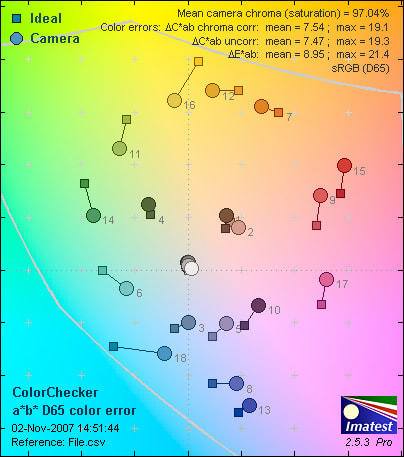
The graph confirms many of the highly saturated colors (the ones uttermost from the white circle at the middle) are reproduced inaccurately. This is nigh credible in the dejection and yellows, which has a stiff consequence on blueish skies and dark-green leafage, making them look unnatural. Overall, the A920 has decent color accuracy, though not every bit expert as nosotros've seen in some similarly-priced models from other manufacturers.

Resolution* (viii.88)
*Resolution operation in digital cameras has a number of factors other than simply how many megapixels a camera has. Sensor blueprint can significantly affect resolution performance, as can the processor. Cameras will over- or undersharpen photos automatically, possibly making them look sharper but calculation ugly image artifacts. We test resolution operation by photographing an industry-standard resolution test chart and varying the focal length and exposure settings. We run these photos through Imatest, which determines sharpness in terms of line widths per picture meridian (lw/ph), as well as the corporeality of sharpening applied in-camera. The units lw/ph represent the number of equally-spaced, alternate black and white lines that can fit across the picture frame earlier becoming blurred.
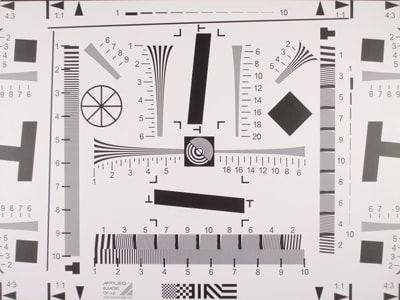
Click on the chart to a higher place to view the total resolution file
The ix-megapixel A920 proved to be sharpest at ISO 100, f/4.1, and a focal length of 17.5mm. The camera resolves 1997 lw/ph horizontally with three.9 pct oversharpening, and 2143 lw/ph vertically with 4.iv percentage oversharpening. These numbers are fantastic, and reiterate the impressive resolution Fuji has accomplished in its cameras over the past few years, even in upkeep models similar the A920. The amount of sharpening applied is merely enough to make the images look slightly sharper without creating ugly image artifacts. These impressive numbers don't tell the whole story, however. When shooting at longer focal lengths, the camera strongly undersharpens photos, negating its impressive resolution capabilities. More chiefly, only the centers of photos are crisply in focus, with the corners and edges looking washed out and blurry. Chromatic aberration is very apparent on the sides of images, and some distortion is evident. Keep these issues in mind if you plan to view or impress your photos large, or crop and enlarge, because the flaws will become much more apparent.
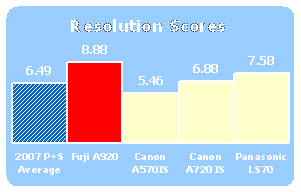
Racket – Transmission ISO* (7.36)
*"Dissonance" refers to the graininess digital images evidence, ofttimes in low lite or shadows. Digital noise is quite different from movie grain, however, and is most always unwanted. Noise can come up in the form of white sandiness or colored splotches, or anything in betwixt. Nosotros test racket levels by photographing our examination nautical chart nether bright, even studio lights at all ISO speeds available. Nosotros run the images through Imatest, which measures noise levels by the percent of image item it obscures.
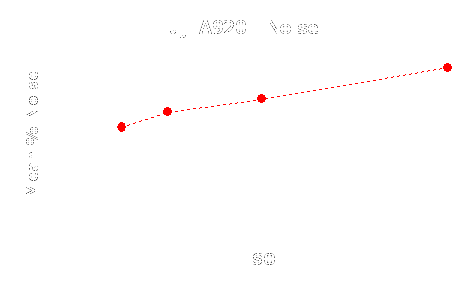
The A920 keeps noise impressively low throughout its limited ISO range. The noise itself is quite ugly, composed of sharp-edged colored splotches, but is just apparent when looked at very closely. Overall, the A920 receives a very good manual noise score.
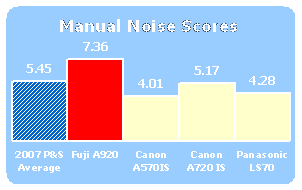
Noise – Motorcar ISO* (one.93)
*We as well test dissonance levels with the camera gear up to Auto ISO, under the same bright studio lights every bit above. Under these bright lights, the A920 chose ISO 400, which is a scrap puzzling, but didn't produce enough racket to be very noticeable.
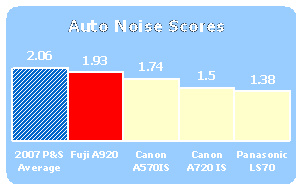
**Still Life Sequences **
Click the thumbnails to view the high resolution images.
**
White Balance*** (5.05)
*White balance has a big outcome on color accuracy in photos. Different types of light have different color casts, from indoor fluorescent to outdoor shade, and cameras must exist able to adapt appropriately. We test white balance accurateness by photographing the ColorChecker chart under four types of light: flash, fluorescent, outdoor shade, and tungsten. We test the Automobile white residual setting, as well as the appropriate presets. The A920 could not focus on the exam chart without a light source shining on it, and then we could non confidently evaluate the accuracy using only the flash.
*Auto (iii.27) *
With the white balance set up to Auto, the A920 is mediocre under white fluorescent calorie-free and very poor under outdoor shade and indoor tungsten. The images beneath show what kind of color cast your photos will have when shooting under these light sources. It is not always the best thought to get out this camera on Automobile white balance.
*Preset (vi.82)
*The presets fare a bit better than the Machine setting. Accuracy is decent nether fluorescent light (using the "Fluorescent Light-3" setting), poor in outdoor shade, and excellent under tungsten lighting. It pays to use the white residual presets on the Fuji A920, particularly when shooting indoors.
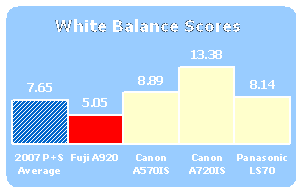
Nevertheless Life Sequences
Click the thumbnails to view high-resolution images.
Depression Light* (4.xviii)
*We've seen how the A920 performs under bright studio lights, but how do photos await in less-than-ideal shooting conditions? We test color and noise operation in low low-cal by photographing the ColorChecker at 60, 30, fifteen, and 5 lux. Sixty lux corresponds to a room lit softly by two lamps, thirty lux approximates the corporeality of lite in a room lit solely by a 40-watt seedling, and fifteen and five lux are extremely night, testing the limits of the sensor. All shots are taken at the highest ISO speed available, which is ISO 800 on the A920.
The A920 cannot expose properly at 15 or 5 lux, showing the photographic camera has clear limits and cannot capture photos in dim situations where a flash isn't desired. At 60 and 30 lux the camera'due south colors suffer, though noise levels stay relatively low. Overall, this is non a good camera for low light shooting.
We too test long exposure performance, but simply at ISO 400 in club to compare cameras evenly. The A920 tin only take exposures longer than 0.25 seconds in Night mode (up to 4 seconds), where ISO cannot be set manually, then we could non examination long exposure operation. Four seconds doesn't allow much room to play around with slow shutter speeds, anyway.
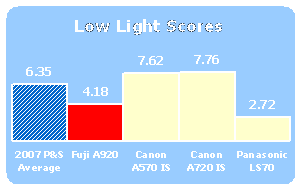
Dynamic Range* (five.66)
*Dynamic range is an image quality factor that tells how big a tonal range a photographic camera tin can detect. This proves of import in scenes with high contrast, where a camera must be able to show detail in the bright highlights besides as the dark shadows. These situations evidence up often at weddings or landscapes shot in bright sunlight. We test dynamic range by photographing a backlit Stouffer step chart at all ISO speeds. The Stouffer chart consists of a long row of gray rectangles that vary in tone from brightest white to darkest black. The more than rectangles a camera tin can discern, the amend its dynamic range.
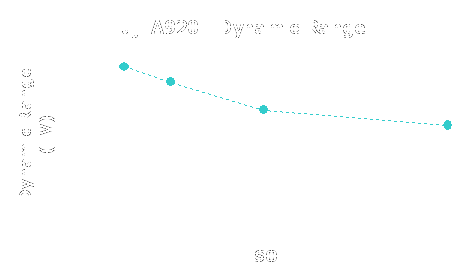
The A920 has good dynamic range at ISO 100, then drops off slowly but steadily at college sensitivities. The camera does a good job keeping dynamic range up at loftier ISO speeds, which is most likely due to its fairly low racket levels. Overall, the camera has slightly ameliorate than average dynamic range, which is dandy for a budget camera.
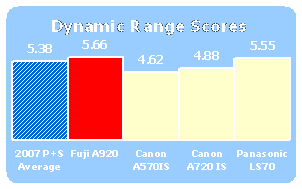
Speed/Timing – All speed tests were conducted using a Kingston Ultimate 120X 2GB SD Card, with the photographic camera set up to highest resolution and best quality, unless otherwise noted.
*Startup to First Shot (6.viii)
*The A920 takes a leisurely 3.2 seconds to plough on and burn its first shot.
*Shot-to-Shot (0.00)
*Very disappointingly, the A920 does non accept a Continuous Shot manner. Capturing action shots volition become a shot in the dark with this camera.
*Shutter-to-Shot (9.0)
*The camera has no measurable lag when the shutter is held halfway down and prefocused, and a lag of 0.iv seconds when not prefocused.
*Processing (3.8)
*The A920 takes 3.i seconds to process 1 4.5 MB full-resolution fine-quality shot taken at ISO 200.
Video Operation* (1.04)
Brilliant Calorie-free – 3000 lux *
We record footage of our colour charts nether bright studio lights set to 3000 lux to see how the video handles color and racket. Under such brilliant tungsten lights, the A920's video has terrible color accuracy, which is actually normal for digital camera video. Noise levels, on the other hand, are very low.
*Low Light – 30 lux
*Colour accuracy is a little better in low calorie-free, just non near equally accurate equally a still photograph. The camera cannot properly betrayal at thirty lux, and noise levels are very high. Forget about capturing depression-light footage of your friends in a nightclub or your family at dusk.
*Video Resolution
*We record footage of our resolution chart to see how the Movie style handles resolution. The tiny 320 x 240 image frame captures only 302 lw/ph horizontally with -ii.seven per centum undersharpening, and 253 lw/ph vertically with -5.4 percent undersharpening. Despite the tiny size and lack of oversharpening, imaging artifacts are still apparent.
*Move
*We also take cameras exterior to meet how the Movie mode renders moving cars and pedestrians. As nosotros mentioned to a higher place, the frame size of the A920'due south video is tiny, and makes it hard to see on a computer screen. The motion has tons of moiré, the exposure "flashes" whenever information technology changes, and vivid highlights bleed across the unabridged frame. The practiced news is the exposure ordinarily looks quite accurate, and the frame is so small it is hard to detect whatever jerkiness in the movement.
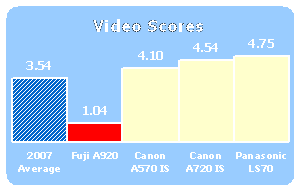
**Viewfinder ***(0.0)*
The Fujifilm FinePix A920 doesn't have an optical viewfinder because its 2.7-inch LCD screen takes up almost of the back. The LCD has a alive view of the action, merely hopefully it isn't moving too quickly, because the refresh rate of the screen isn't great. Moving subjects, especially those shut to the photographic camera, expect blurry and jittery.
There is a display button that changes what appears on the live view. The screen tin can show only the image, or information technology can add basic file info and composition guidelines, or merely bones file info. Later on a picture is taken, the screen blacks out for a moment. That blackout time lengthens when the bombardment is worn down.
The screen is a good size, but its resolution isn't great and its refresh rate is unimpressive, so information technology isn't perfect. Information technology does take a 100 pct accurate view of the recorded image, nevertheless.

The 2.7-inch LCD on the Fuji A920 upgrades from its predecessor by but 0.2 inches. It isn't much, merely it'southward something. The resolution remains equally bad at 115,000 pixels. This poor resolution makes information technology hard to encounter if subjects are in focus, whether they're moving or still.
The poor resolution is common on upkeep digital cameras, though. The Canon PowerShot A630 and Sony Cyber-shot DSC-W55 both take two.5-inch screens with 115,000 pixels. The $199 Kodak EasyShare V1003 has a 2.5-inch screen with 154,000 pixels.
The LCD doesn't have very wide viewing angles. Users have to look at it straight on or from above, because when the photographic camera is held in a higher place eye-level or to the sides nil but a negative-similar image can be seen. Outdoors in sunny weather condition, the A920'southward anti-glare coating doesn't piece of work very well: the screen often looks washed out.
The amorphous silicon TFT LCD's brightness can be adjusted on a +/- five calibration in the Setup card, and features a live view and so users can come across the effects of their changes. The LCD can too be brightened more quickly with the top of the multi-selector – one push button automatically brightens it a notch. There is also an LCD Ability Save mode that can exist turned on and off; when on, it dims the image on the screen after 10 seconds of inactivity.
The Fuji A920 may have one of the biggest LCD screens offered on a $199 camera, but its resolution is naught to boast about.
**

Flash ***(v.5)*
The Fujifilm A920 has a relatively big flash located in the upper right corner of the front – just where the left fingers sometimes wrap around the camera. Beware: fingers may block the flash and render it completely ineffective.
The flash fires automatically about of the time, but there are a few Flash modes that can be accessed in Manual and a few other exposure modes, Options include Auto, Reddish-Eye Reduction, On, Off, Slow Synchro, and Cerise-Eye Reduction + Tedious Synchro.
The flash is constructive from 2 to 12.8 feet when the lens is zoomed wide and 2 to 5.9 feet when in telephoto. In Macro mode, the flash is effective from 1 to 2.6 feet.
The Fujifilm FinePix A920'due south flash lets off a surprisingly even low-cal. There aren't major hotspots or serious darkening on the edges like on some upkeep digital cameras. The corners of the frame aren't quite as bright, but this is mutual, even on pricier models.
In that location is a Cherry-red-Center Reduction preset exposure manner on the mode punch. It has the aforementioned menu options as Auto mode, merely uses only a reddish-eye reduction wink, theoretically. Simply because information technology takes the photographic camera near 15 seconds to reboot between flashes, pictures taken in that 15-2d window don't utilise the flash at all.
This slowness isn't merely in the Cherry-Heart Reduction scene mode – it happens anytime the flash is used, although the window can shorten to nearly six seconds at times. The flash has decent coverage and typical attain for a camera of this caliber, but its slow reboot leaves a lot of photos in the night.

The A920 has the same Fujinon 4x optical zoom lens included on the A900. It measures viii.8-35.2mm, an equivalent to 39-156mm in the 35mm format. This is quite narrow, making group portraits a tough photography feat. The Canon A630'south 4x lens is wider with its equivalent 35-140mm focal range.
The zoom is controlled by a zoom ring that surrounds the shutter release button. It doesn't move very much; it feels like it is wound besides tight. When pushed gingerly, users tin can stop at 12 focal lengths throughout its range. This is skillful for a camera in this price range. The lens doesn't backfire or exhale, but it does make a piddling mechanical noise when information technology zooms in and out.
There is a Macro focus way that is turned on by pushing the left side of the multi-selector. Lens barrel distortion is most evident in this mode. Be careful when photographing close-up objects or text, considering straight lines will look bowed.
Digital zoom tin can exist turned on and off in the Setup bill of fare, although at that place is likewise a Digital Zoom exposure style on the punch. Despite its prominent placement, it should not be used oftentimes because digital zoom degrades image quality. The Digital Zoom mode uses 3x digital zoom and doesn't allow the optical zoom to be used; it fixes the focal length at its nearly telephoto 156mm. The standard digital zoom that operates in whatsoever mode has 7.6x ability – enough to make photos expect absolutely horrific, even with poor LCD resolution.
Overall, the 4x lens is decent for the price. It'southward nice to have more than than the boilerplate 3x camera, only the lens is nonetheless narrow and low-quality.
**Model Pattern / Appearance ***(4.5)*
The Fujifilm FinePix A920 is not pretty. Information technology aims to be "sensible," as Fujifilm'southward website puts information technology. There is a tacky mix of chrome and argent-colored plastic with a sprinkling of cheap buttons. The thick torso simply makes things look worse. If consumers are looking for a more than bonny camera, the 7.two-megapixel Fuji Z10*fd* comes in five colors and has a thinner body – and sells for the aforementioned $199 toll.
**Size / Portability ***(6.25)*
The 3.8 x ii.4 x ane.3-inch digital camera isn't skinny enough to cram into a pants pocket. It is meaty plenty for a purse or coat pocket, but wouldn't be comfy in a more confined infinite. The Fujifilm A920 weighs 5.5 ounces without the card and 2 AA batteries; it feels heavier than one would think from the plastic trunk. Information technology won't sprain ligaments or overexert muscles to elevator and handle it; in fact, the weight makes it feel more substantial than it is. Users should utilise the supplied wrist strap on the right side of the camera to continue information technology from hitting the physical.
**Handling Power ***(6.five)*
At that place aren't many handling considerations on this FinePix. The A920 is non ultra-thin, but notwithstanding aims to be more portable than comfortable. The right side is slightly thicker to accommodate the gripping hand. There is a lightly textured semi-circle on the forepart and a few plastic bumps on the back, simply non much else to keep fingers from slipping around. The left fingers volition have to watch out for the flash component, as the fingers and flash compete for space in the upper right corner of the front.
**Control Button / Dial Positioning / Size ***(half-dozen.0)*

The controls on this digital camera are typical of a compact model. In that location is a fashion dial in the upper right corner of the back, keeping the exposure modes inside a glance of the eye at all times. Likewise on the back are low-quality plastic buttons. They are all nicely-labeled merely small. Navigation could be difficult for those with big fingers. Hitting the shutter release won't exist a problem, though: it is a good size, domed, and placed atop the camera in a prominent position. Around the shutter release is a zoom band that feels too stiff. Overall, the buttons are a bit too low-quality and minor, but are typical of a sub-$200 model.
**Carte ***(seven.0)*The Fujifilm FinePix A920 upgrades from before models with a "new" graphic user interface. Zip much is new, howver, except a few colorful flairs. The Recording card is shown on a darkened background with white chimera-like boxes behind the black text of each line. When an selection is selected, the text turns white and the background of the bubble turns a vivid colour. The background of each item is a unlike color. For example, the groundwork of the "scene position" selection is green, and the background of ISO shows upward orange. Similar other FinePix menus, the menus are displayed in all capital letters.
It'due south piece of cake to return to the Main menu from the ISO, quality, exposure compensation, and white residue options. Once a Recording way is chosen, however, users are kicked out of the menu system, which can lead to extra steps and frustration. There are live views for exposure compensation and white balance options, but nada else. The Setup carte du jour shows up on a solid light gray background and, like the Recording bill of fare, includes tiny graphics side by side to the text titles. There are iv tabs across the top of the menu – the start has a photographic camera icon and the other 3 have wrenches. The Setup card is as follows.
Once again, it is easy to get kicked out of the Setup menu organization, so users who take to brand more than than one adjustment may discover themselves entering and re-entering the carte du jour several times.
The menu organisation, while more colorful than before, even so isn't flawless. Sometimes at that place are menu items placed unnecessarily, similar the ISO detail in the Auto recording style that offers only an Auto setting. Still, the menus are easy to discover with the designated menu push button and navigate with the multi-selector.
**Ease of Use ***(7.75)*
The point-and-shoot style of the FinePix A920 makes information technology easy to pick up and take a picture without even glossing over the bones user manual. The elementary mode dial makes it like shooting fish in a barrel to discover exposure modes, the Automobile manner being the ruddy photographic camera icon that sticks out the near and is probably nigh useful for beginning photographers. The shutter release button and other controls are placed intuitively, besides. Menus aren't as streamlined, but Fujifilm added tiny assistance icons next to the standard text. Overall, the A920 is easy enough to use that a 3-year-old could probably take a decent picture show with it.
**Machine Way ***(vii.0)*
The Auto mode is the only ruddy-colored icon on the fashion punch, so information technology is easy to find and access quickly. When the carte button is pushed in Auto manner, only ISO, image quality, and Setup menu options appear. Interestingly, the ISO can only access an unchangeable Motorcar setting, making its placement in the menu unnecessary. The options on the multi-selector can even so exist used. The A920's Auto mode is very piece of cake to use.
**Movie Mode ***(iv.0)*
The Fujifilm FinePix A920 has a 320 x 240-pixel Movie mode. Many digital cameras accept twice the resolution. A camera for this toll isn't going to double as a camcorder, merely at that place are budget cameras with ameliorate Motion picture modes.
Videos are recorded at xxx frames per second (fps), and so moving subjects await smooth. The optical zoom cannot exist inverse while recording movies, only the digital zoom functions. Unfortunately, information technology only enlarges the existing pixels and makes the resolution look much worse. Mono sound is recorded simultaneously in Movie mode, and is surprisingly decent. It'south non crystal clear, but sounds better than near sub-$200 cameras.
Nosotros tested the camera's Motion JPEG files and found several problems. There is lots of moiré, the metering is finicky, and brilliant portions of the frame bleed to other portions of the frame. There are more details in the Testing/Performance department, merely the Fuji A920's videos are not stellar in any way.
The A920's Movie style is the aforementioned as its predecessor'southward. It is similar to Sony's S700, which also shoots 320 x 240 pixels at 30 fps. Not all budget cameras take low-resolution Movie modes, though. The Canon A630 and Fuji Z10*fd* both shoot standard 640 x 480-pixel videos at 30 fps. The $149 Panasonic LZ6 has standard 640 x 480 and widescreen 848 x 480-pixel videos with audio – and throws in image stabilization. Conspicuously, at that place are better options on the market.
**Drive / Burst Manner ***(0.0)*
The FinePix A920 does not have a Continuous Shooting mode, so users volition likely have simply i take a chance to capture a split-second basketball dunk. When the camera's batteries are fresh, the camera can snap a flick about every four seconds. This is archaic in an age when most digital cameras can snap two frames per 2nd.
The A920 does take a self-timer, which can be set to delay for either two or 10 seconds by pushing the bottom of the multi-selector. The camera sends out an orange beam from the lower right corner of the front to betoken when the film will be taken.
**Playback Mode ***(six.75)*The Playback manner is attainable by a button instead of a position on the mode punch, making it quicker to return to recording pictures afterwards. Users can simply push the shutter release button to exit Playback mode. Pictures tin be perused i-by-one by touching the left and right sides of the multi-selector. Tapping the top deletes private pictures. Scrolling through images isn't a quick process; information technology takes almost a half-second for the photographic camera to register and move along to the side by side image after the button is pushed. That's annoying. Scrolling through images can exist done faster by pushing the display button, which shows alphabetize screens of ix images per folio and also shows a calendar view with 12 images per folio. Virtually of the Playback way'due south options are outlined in its bill of fare.
The Playback mode packs the basics like deletion and slide evidence, but doesn't include fancy color effects or even red-eye fix. It does have infrared wireless communication between other IrSimple-enabled devices, merely unfortunately that technology isn't very prevalent and images can but be transferred one at a time – making information technology a laborious process to send all images off a 1GB card. Videos can be played dorsum with a 0-ten volume adjustment hidden in the Setup carte du jour. Videos tin be played, paused, fast-forwarded, and rewound, but non edited.
Overall, the Playback mode is very basic. The ii.7-inch brandish screen doesn't have fabled resolution or viewing angles, so gathering friends around for a slide evidence won't be as enjoyable every bit on more expensive digital cameras.
**Custom Image Presets ***(7.25)*
The Fujifilm FinePix A920 comes with a decent set of Scene modes because its toll range. In that location are a few Scene modes located directly on the mode punch, with the rest tucked into a menu under the "SP" position. Portrait, Digital Zoom, Red-Eye Reduction, Moving-picture show Stabilization, and Baby modes are directly on the dial. Some of these seem more like features rather than full modes.
Digital Zoom mode should never be used because it degrades image quality. It uses 3x digital zoom and fixes optical zoom at its almost telephoto focal length. Pictures wait fuzzy and edges like jagged stairs. The Red-Eye Reduction style but activates the red-eye reduction preflash, but the flash isn't guaranteed to burn down at all times. It takes the flash a total 15 seconds to reboot between pictures, so any shots in betwixt will exist flash-less.
The Picture Stabilization manner shouldn't be confused with optical prototype stabilization. Information technology isn't nearly equally effective and brings in more than noise than it should. This preset mode simply increases the ISO sensitivity up to 800 and speeds up the shutter to freeze activity.
The following exposure modes are located in the SP menu: Transmission, Landscape, Sport, Dark, Natural Light, Embankment, Snow, Fireworks, Sunset, Underwater, Flower, Party, Museum, and Text. This is a healthy fix of Scene modes, but an odd place to cram the Manual mode. Granted, it isn't really Manual – it doesn't let users to manually accommodate shutter speed or aperture. Information technology does, however, offering the most transmission controls. About digital cameras give this exposure fashion its ain spot on the dial, merely the A920 opts to hide it among the Scene modes.
**Transmission Control Options
**At that place aren't many manual controls on the Fujifilm A920. There is an exposure style called Manual, but information technology doesn't have control over shutter speed and aperture and would exist more accurately titled Plan. It is curiously placed in the "SP" position of the mode dial with a series of Scene modes. The Transmission fashion, however, allows total admission of the menu and the few manual controls that there are: white remainder, ISO, and exposure compensation.
**Focus
***Autofocus (vi.0)
*The autofocus is nigh every bit automatic every bit information technology can go. There are no autofocus options in the carte du jour system. The through-the-lens dissimilarity type autofocus does not run continuously; it but focuses when the shutter release button is pushed. The AF frame is fixed to the center at all times, and so off-centre subjects are ofttimes out of focus. The only pick the camera allows the user to brand is whether to actuate the Macro mode, which can focus from iii.nine inches to two.half dozen feet when the lens is zoomed wide. When zoomed to telephoto, the Macro mode can focus from 0.ix to 2.6 feet. Usually, the A920 can focus from 2 feet to as far as the lens can encounter. The autofocus system isn't quick. It takes the camera about a full second to focus on subjects; expect more than a few blinked optics. There is enough to slow the autofocus system downwards, too: when the lights are dim or the batteries low, information technology takes even longer.
*Manual Focus (0.0)
*There is no manual focus on this digital photographic camera. This is most likely for the best – this demographic probably wouldn't use manual focus, and the LCD screen's poor resolution makes it difficult to estimate focus, anyway.
**ISO ***(6.75)*
The Fujifilm FinePix A920 has scant options in terms of ISO sensitivity. That is to exist expected for such an inexpensive camera, though. Its range consists of Machine, 100, 200, 400, and 800 options.
There is a Picture Stabilization mode on the fashion dial that increases the ISO upwards to 800. It as well quickens the shutter speed to freeze activeness. This method of blur reduction has issues, all the same – it brings with it an increase in noise.
The Testing/Functioning section has more than details, only the ISO settings generally performed well when correlated dissonance was tested. The camera performs improve when the ISO is manually fix, though.
**White Remainder ***(half dozen.0)*
In the Recording menu there are a few white balance options. There isn't a manual white balance setting, but that is to exist expected on a budget digital camera designed for beginners. Auto, Fine, Shade, Fluorescent Daylight, Fluorescent Warm White, Fluorescent Cool White, and Incandescent options are on the docket.
We tested the accuracy of the Automobile white balance setting versus the presets; more than specifics are bachelor in the Testing/Operation section, simply in the terminate the presets are more accurate.
**Exposure ***(vii.0)*
This digital camera has mainly automated exposure modes; its most transmission mode is chosen Manual, just is more than of a Program mode. It can't adjust shutter speed or discontinuity, simply has an exposure compensation feature that adjusts both in a simpler +/- two scale, with steps every third of an exposure value. This is the typical range offered on digital cameras, even upkeep ones.
**Metering ***(five.0)*
The Fujifilm FinePix A920 has a 256-zone metering arrangement that operates automatically. There are no Metering modes available to choose from. Most digital cameras offering Boilerplate, Center-Weighted, and Spot metering options, merely the A920 leaves the average metering to the camera. Exist careful when photographing backlit subjects, because they will plough instantly into silhouettes against the vivid lighting behind them.
**Shutter Speed ***(0.0)*
The shutter speed is chosen automatically past the A920. The total shutter speed range is 4-ane/1200 of a second, just the shutter speed is greatly influenced by the selected exposure mode. For instance, Dark mode selects slower shutter speeds than Snowfall style.
The A920'south shutter speed range isn't very impressive. The $149 Panasonic LZ6's shutter speeds vary from 60 to one/2000 of a second. The $199 Sony W55 ignores longer exposures with its one to 1/2000 of a 2d range, and the $199 Fujifilm Z10fd's shutter speeds are even more than limited, from 3 to 1/1000 of a second.
**Discontinuity ***(0.0)*
The Fujinon 4x optical zoom lens has a limited discontinuity range. At the lens' widest, a maximum f/2.9 discontinuity is available. This lets in plenty of light. When the lens is zoomed in, though, the max aperture shrinks to a very pocket-size f/6.3. This doesn't allow much light to pass through the lens onto the epitome sensor. Well-nigh comparable digital cameras let more light in effectually the telephoto terminate of the lens, only less low-cal when the lens is at its widest. The smallest the aperture can go is f/7.i; most digital cameras have a minimum discontinuity of f/8.
To compare, the Panasonic LZ6'due south 6x lens has a wide max aperture of f/two.viii that shrinks to f/4.5 when zoomed in. The Fujifilm Z10fd's 3x lens has a smaller f/3.7 aperture when zoomed wide and f/iv.nine when zoomed in. The SonyW55'due south 3x lens has corresponding max apertures of f/2.viii and f/v.ii.
**Picture Quality / Size Options ***(6.five)*
The Fujifilm FinePix A920 has more resolution than the average $199 digital camera. Most cameras in this cost range hover around seven megapixels, which is nevertheless plenty to produce cracking 4 x 6-inch prints and even some enlargements. The A920 comes onto the market with 9 megapixels on a Super CCD; this is the same amount of resolution as its predecessor, the A900. The A920 has a larger image sensor that measures 1/1.6 inches – most digital cameras pack along a smaller 1/2.5-inch CCD. The Fujifilm FinePix A920 has the following image sizes selectable in its Recording bill of fare: 3488 x 2616, 3:2 (3696 x 2464), 5M (2592 ten 1944), 3M (2048 x 1536), 2M (1600 x 1200), and 0.3M (640 x 480). The meridian resolution is bachelor in Fine and Standard compression settings; the rest of the options operate at Standard compression.
Subsequently a few rounds in our imaging test lab, the Fujifilm A920 came out mostly victorious in this area. Its ix megapixels prove to exist extremely constructive at capturing detail, especially for a sub-$200 digital camera.
**Motion-picture show Effects Style ***(0.0)*
There aren't any movie furnishings available on this budget digital camera. Most models at least include blackness and white and sepia colour effects, just the Fuji A920 forgoes fifty-fifty those bones options. If consumers want more effects, the Sony W55 has a traditional set of Black and White, Sepia, Rich, and Natural color modes.
**Connectivity
***Software *(five.0)
The Fujifilm FinePix A920 comes with a CD-ROM that has several versions of FinePix Viewer on it. FinePix Viewer S version 2.one and FinePix Viewer version 5.3 are bachelor for Windows, and FinePix Viewer version 3.four is available for Macintosh.
The FinePix Viewer software took only a few minutes to install, but it doesn't automatically load pictures from the computer. Every image must be manually uploaded into the program itself – although this tin be done in batches. The opening screen to the plan is the access signal to the following options: view photos, slide show, print, load photos, and east-postal service. Unfortunately, users can't admission everything from anywhere else – for example, users cannot load photos while viewing other photos.
When browsing in the "view photos" department, users can organize photos by date on the left side of the screen and adjust the size of the images in the upper right corner. File info of the selected epitome is shown in the lower left corner, and a few buttons are in the lower correct – large view, auto arrange, rotate left, rotate correct, and delete. The elevation of the window shows a few shortcuts to print, email, and play slide shows.
The "edit" push button offers few editing options, near of which already have shortcuts on the master screen. Users can rotate, auto adjust, and delete images, besides as change the engagement and fourth dimension and edit the comment. What happened to color balancing or contrast adjustments?
The print portion of the FinePix Viewer has several simplified options: full-sized print, index print, and design print. Users can also upload photos online from here, if the computer is connected to the Net.
Overall, the FinePix Viewer Software is extremely simplified: users tin't even resize or crop images. If users but want to impress with this software, information technology works just fine. But users volition want to purchase a program for annihilation else, including posting smaller pictures to blogs or cropping photos.
*Jacks, ports, plugs *(3.5)

The A920 stacks its jacks on its left side. They are very visible because they are completely exposed. Almost digital cameras have a rubber flap that snaps over the jacks, merely this model forgoes whatever protective measure. The open ports mean a shorter life bridge for the camera. It's only a matter of time before dust, moisture, and other foreign material notice their style into the body of the photographic camera.
The jacks include USB at the top, AV-out in the center, and DC-in at the lesser.
The AV-out function tin exist set to NTSC or PAL standard then pictures and videos tin can exist viewed on televisions around the globe. The AV and USB cables are included with the photographic camera. The 3-volt DC-in cable can exist purchased separately through the manufacturer's website.
Directly Impress Options (six.0)
The Fujifilm FinePix A920 is PictBridge compatible. The camera tin can create impress orders through the DPOF pick in the Playback menu. Users can ringlet through images and add them to the print lodge. Pictures can be printed with or without the date on them. The number of prints can be ready from 0-99 on the camera'due south print order. Unfortunately, there is no option to add together all images to a DPOF print order at once. The camera can be connected to a printer through the supplied USB cablevision and the open jack on the left side of the camera body. The port does not have a embrace, so information technology will exist easy for information technology to gather dust from backpacks, moisture from the air, and sand from the latest holiday.
*Battery (v.5)
*This digital camera is powered by 2 AA batteries. Many digital cameras take lithium-ion batteries, merely it is mutual for budget models to use AAs because they are convenient and piece of cake to find at a drug store. The batteries fit into a flimsy door below the right side. When opened, the batteries instantly fall out: there's zip to hold them in identify.

There is a belch battery option in the setup menu that should only be used on rechargeable NiMH AA batteries – not on the alkaline type purchased at almost convenience stores. This acts as a sort of standard oil change for such batteries, and should exist used when they don't last equally long as they used to and when a new set is purchased.
*Memory (3.75)
*Recent Fujifilm models, including the A920, are offer SD card support in addition to the xD-Picture carte du jour compatibility they've had for a few years. The A920 also accepts SDHC media, a slight upgrade from the A900, whch could have SD and xD, just not SDHC. There is also 10 MB of internal memory, the same amount the older A900 has. This is only enough to concord one full-resolution paradigm, so users will want to take some form of external memory handy.
**Other features ***(five.5)*
IrSimple Wireless Image Transfer – All new Fujifilm FinePix digital cameras include this engineering, which can transfer images from the camera to an enabled computer, printer, or other device without using the USB cable. The infrared signal travels from the left side of the photographic camera above the open ports. It can communicate within three anxiety of the enabled device, so it isn't like the Bluetooth-enabled Kodak EasyShare V610, which tin wirelessly ship pictures across the business firm. The IrSimple applied science is much less expensive to produce than Bluetooth, simply isn't as prevalent on devices in Due north America. Fujifilm expects this technology to expand in 2008. Users can transfer images between Fujifilm digital cameras, only need IrSimple compatibility on computers to really benefit. The images can but be transferred in the Playback mode 1-by-one, and then the USB cable should notwithstanding be used for transferring big numbers of images and videos.
Waterproof Housing – The Fujifilm A920 comes with an Underwater scene way, so it is fitting that this manufacturer sells an optional waterproof housing, which Fujifilm calls an "aquamask." The Fujifilm WP-FXA800 retails for $69 and can have the camera to depths of x feet. That isn't deep enough for scuba diving, but would be fine for snorkeling. It's non a bad investment to have this polycarbonate housing for trips to the beach, where sand can easily get into the open up ports on the side of the camera.
**Value ***(6.25)*
The Fujifilm FinePix A920 was announced in July 2007 and made its debut on store shelves one calendar month after for $199. This is the aforementioned original retail price of the A900. The toll puts information technology in the budget segment of the market place, just the competition here is heated. The A920 has the edge on resolution – few cameras at this price offer 9 megapixels. Other cameras offer tempting features, though. The Panasonic LZ6 packs a 6x optical zoom lens and optical prototype stabilization, along with a Movie fashion that shoots widescreen and standard movies at twice the resolution of the A920 – and for a lower $149 price. Consumers who want nifty images will be pleased with the A920, but other cameras offer more features and amend components.

Fujifilm FinePix A900 –* This 9-megapixel digital photographic camera was appear in Feburary 2007 and released in the spring, only to be nearly forgotten when the A920 rolled effectually in the fall. The older model has the same resolution, exposure modes and controls, flash component, and Fujinon 4x optical zoom lens. Its LCD screen is slightly smaller at ii.5 inches, and they share the same lackluster 115,000-pixel screen resolution. The A900 has an ancient graphic user interface and does not have SDHC media, although it takes standard SD and xD-Flick cards. The A900 originally retailed for $199.

Fujifilm FinePix Z10fd – For the same $199 cost, consumers can get a digital camera that looks good. It comes in a thinner 3.vi ten 2.2 10 0.seven-inch torso that is bachelor in five colors. It has the same exposure modes and many of the aforementioned controls, but its Movie manner is ameliorate with 640 x 480-pixel resolution at 30 fps. Its ISO 64 to 1600 range is more expansive, too. The Z10fd has vii.ii megapixels and a shorter 3x optical zoom lens, only adds face detection and 54 MB of internal memory. Information technology also has a Blog mode that automatically copies images in smaller sizes for faster uploading, which tin exist done with the included IrSimple wireless transfer technology. This FinePix has a slightly smaller 2.five-inch LCD screen, but a better 150,000-pixel resolution. It also runs on a lithium-ion battery, and so users won't have to buy a fresh gear up of AA batteries every few days.

Canon PowerShot A630 – The A630 has a sturdier but thicker 4.3 10 ii.half-dozen 10 1.9-inch body that offers more manual modes and controls. It has a fully Manual fashion, with options to adjust shutter speed, discontinuity, white balance, ISO, and other parameters. There is a host of color filters and effects available, as well every bit a 1.8 fps Flare-up way, a feature left off the Fuji. The Canon A630 has a 4x optical zoom lens, but slightly less resolution at 8 megapixels. It has a 2.five-inch LCD screen that folds out and rotates, but the same crummy 115,000 pixels. There is likewise an optical viewfinder. Pictures tin can be snapped in widescreen format, and videos can be shot at twice the resolution: 640 10 480 pixels. The A630 sells for less than $250.

Panasonic Lumix DMC-LZ6 – The similarly-sized FZ6 skimps on design merely fits into the budget at $149. Information technology has 7.2 megapixels and a tiny 2-inch LCD screen with 86,000 pixels. However, information technology has a longer 6x optical zoom lens and optical epitome stabilization. It also has 18 Scene modes and a Moving-picture show mode that records 640 x 480 and widescreen 848 ten 480-pixel videos at 30 fps. It is powered by 2 AA batteries like the Fuji, merely has more internal memory with 27 MB.

Sony Cyber-shot DSC-W55 – This digital photographic camera is less than an inch thick and looks classy while offering ease of use on a budget. The W55 has 7.2 megapixels and a 3x optical zoom lens. It also has a two.v-inch LCD screen with 115,000 pixels. Information technology has a similar level of exposure control with its 7 Scene modes, but doesn't take fully transmission modes. It offers options like exposure bounty, ISO, and white balance, though. Its ISO extends upwards to 1000. The W55 runs on a 380-shot lithium-ion battery and comes with 56 MB of internal retentivity. It retails for the same $199 cost.
**Who It'south For
***Point-and-Shooters –* This digital camera is designed for this group of users. It is easy to use and easy to transport.
*Budget Consumers – *At $199, the Fujifilm FinePix A920 is a prime candidate for these consumers – although there is sexier competition out there at this price.
Gadget Freaks – It does have IrSimple wireless advice engineering science, but that is the extent of its gadgetry. It probably won't exist enough to draw in this oversupply.
Manual Control Freaks – The and then-chosen Manual mode is buried in the Scene mode menu: that should say something. These consumers will freak out in a bad way with the A920.
Pros/Serious Hobbyists – In that location is no take chances professionals or fifty-fifty hobbyists will consider the A920 their photographic camera of choice.
**Conclusion
**The 9-megapixel Fujifilm FinePix A920 has more resolution than near sub-$200 digital cameras, but its feature set is otherwise basic. It has a cheap 4x optical zoom lens and a 2.seven-inch LCD screen with blocky resolution of 115,000 pixels. It has mainly automated modes, with its most Manual mode buried in the Scene manner menu.
The plastic trunk isn't very durable, and the open up ports on the left side are an accident waiting to happen. One trip to the beach and sand will collect in the jacks and ruin the contacts. A sprinkling of pelting could rust them out, too.
Despite these limitations, the Fujifilm A920 can take great pictures. It has first-class resolution, depression noise, and good dynamic range that make its images expect dainty and clean. Information technology doesn't perform well in low light and the autofocus system is slow, only it takes beautiful portraits when the field of study is well-lit and gear up to smiling for about a half-second.
The A920 is piece of cake to employ and fits well into most budgets, but there is hot contest at this price. There are sub-$200 cameras with meliorate components and features, simply in that location are inappreciably any that will have such effective resolution and produce such make clean images.
**Sample Photos
***Click to view the high resolution image.
*
Meet the tester

Emily Raymond
Editor
Emily Raymond is a valued contributor to the Reviewed.com family unit of sites.
Checking our work.
Our squad is here for one purpose: to help you lot buy the all-time stuff and love what you own. Our writers, editors, and lab technicians obsess over the products we cover to make sure you're confident and satisfied. Accept a different opinion about something we recommend? Electronic mail united states and we'll compare notes.
Shoot the states an e-mail
Source: https://www.reviewed.com/cameras/content/fujifilm-finepix-a920-digital-camera-review-16259
0 Response to "finepix A920 files upload to computer automatically"
Post a Comment